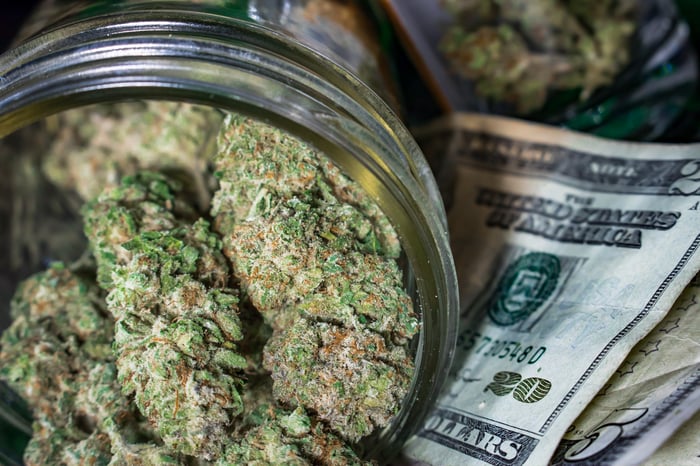Last year began with a mountain of promise for the cannabis industry. Canada had recently legalized recreational pot and high-margin derivatives were slated to hit dispensary shelves later in the year. Meanwhile, momentum for state-level legalizations in the U.S., the most lucrative marijuana market in the world, remained high. In short, it looked like the perfect recipe for cannabis stocks to push into profitability.
But hindsight being what it is, we know that this vision didn't come close to reality. As we move headlong into a new decade, marijuana stocks remain unprofitable almost across the board, at least on an operating basis (i.e., without the aid of one-time benefits).
However, if investors haven't done the appropriate amount of digging, they may not realize just how unprofitable cannabis stocks really are. You see, a number of popular marijuana stocks have been able to "trick" investors by posting surprise profitable quarters. I say "trick" in quotation marks because what pot companies are doing is perfectly legal -- but they're not going to advertise that their profit wasn't the result of operational success.
Here are three ways cannabis stocks may be tricking you when it comes to profitability.

Image source: Getty Images.
1. Fair-value adjustments
One of the biggest differences between Canadian and U.S. pot stocks is that Canadian marijuana stocks almost exclusively report their operating results using International Financial Reporting Standards (IFRS) as opposed to generally accepted accounting principles (GAAP). This creates some perfectly legal above-the-line adjustments that can have a big impact on a marijuana stock's bottom line.
For example, cannabis grower Aphria (APHA) wound up reporting two consecutive quarterly profits in the fiscal fourth quarter of 2019 and fiscal first quarter of 2020. Including Aphria's pharmaceutical distribution operations, its total sales hit $126.1 million Canadian, with cost of goods sold of CA$98.6 million. This meant Aphria generated a gross profit of CA$27.6 million (when rounded) before factoring in operating expenses.
But before dropping down to operating expenses, Aphria has to deal with its fair-value adjustments. These accounting procedures require the company to estimate the value of their current crop (which can change based on the growth stage of cannabis plants), as well as estimate/adjust the cost to sell these goods. In many instances, this is done months before a company actually sells its pot products. In Q1 2020, the fair-value adjustment on the sale of inventory cost Aphria CA$7.3 million, but it received a CA$25.2 million above-the-line boost from the fair-value adjustment on growth of its biological assets.
Instead of reporting a gross profit of CA$27.6 million, Aphria was able to report a CA$45.4 million gross profit, after fair-value adjustments. This adjustment is wholly responsible for Aphria's two consecutive quarterly profits. Without it, the company would have reported an operating loss in both quarters.

Image source: Getty Images.
2. Derivative liability revaluation
A less-common "trick" that marijuana stocks have used to generate huge quarterly profits is the revaluation of derivative liabilities (i.e., warrants).
Ontario-based Cronos Group (CRON 0.81%), for instance, has reported three consecutive quarterly "profits" of CA$1.19, CA$0.51, and CA$1.61 per share, which blew Wall Street's expectations for a modest loss per share each quarter out of the water. Without doing the appropriate due diligence, Cronos' earnings per share might make it look like a bargain. But a deeper dive shows that these huge profits are due to nothing more than derivative liability revaluations.
When Cronos Group closed an equity investment from tobacco giant Altria Group in mid-March, it received a whopping $1.8 billion in cash. In exchange, Altria netted a 45% equity stake in Cronos, as well as warrants that could be executed in the future for additional shares of the company. Altria also possesses certain anti-dilution rights, allowing it to purchase shares of Cronos from time to time to maintain its ownership percentage.
As a result, Cronos decided last year that these warrants will need to be treated as derivative liabilities that should be revalued with the quarterly changes in Cronos Group's stock. The company's precipitous decline last year aided Cronos' bottom-line in a big way, thanks to these derivative liability revaluations. But the fact remains that the company continues to lose quite a bit of money an operating basis, without inclusion of these revaluations.

Image source: Getty Images.
3. Asset disposition/revaluation
Finally, it's important for investors to look past the noise surrounding investment sales or investment revaluations, which are one-time events and fail to accurately portray how an underlying business is performing.
For instance, Aurora Cannabis (ACB -6.81%), the most popular pot stock, has been an active (and successful) investor in the marijuana space. It, at one point, owned a 17% stake in pot grower The Green Organic Dutchman, which Aurora had initially classified as an "investment in associates and compound instruments." However, Aurora wound up reclassifying its investment in TGOD as a marketable security not long after its May 2018 initial public offering. Doing so wound up leading to a realized gain of CA$144.4 million.
But the fact is, a deeper dive shows Aurora Cannabis to be nowhere near profitability. The CA$75.2 million in net sales recognized in Q1 2020 pale in comparison to its CA$32.7 million in cost of goods sold and CA$131.1 million in operating expenses. Even with fair-value adjustments, Aurora remains firmly in the red on an operating basis.
Long story short, investors have to be willing to dig into the income statements of cannabis stocks, because they often contain a number of perfectly legal accounting tricks that make their results look a lot rosier than they actually are.





